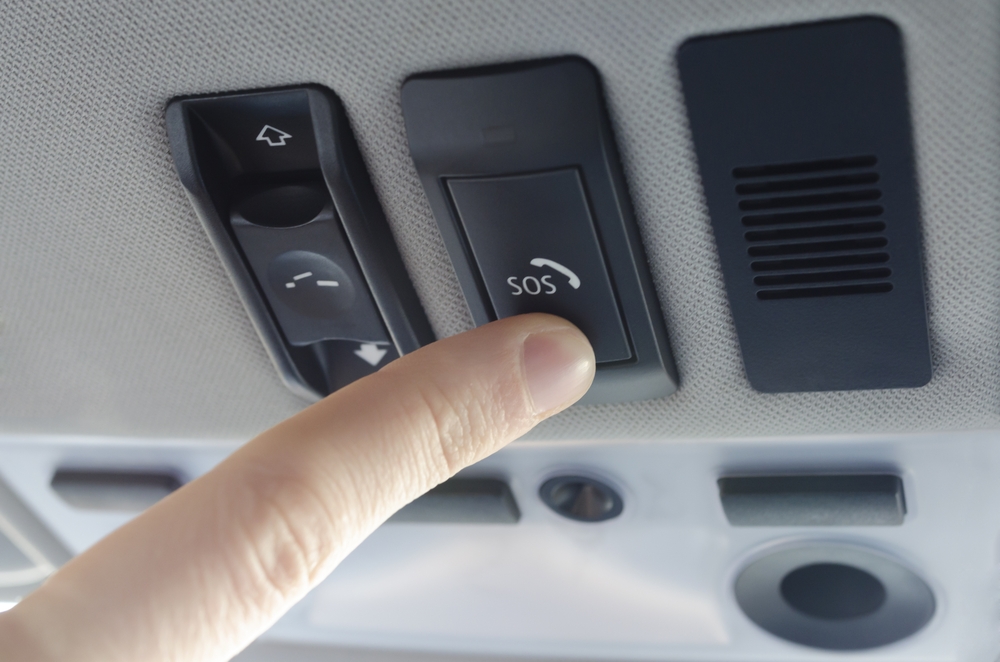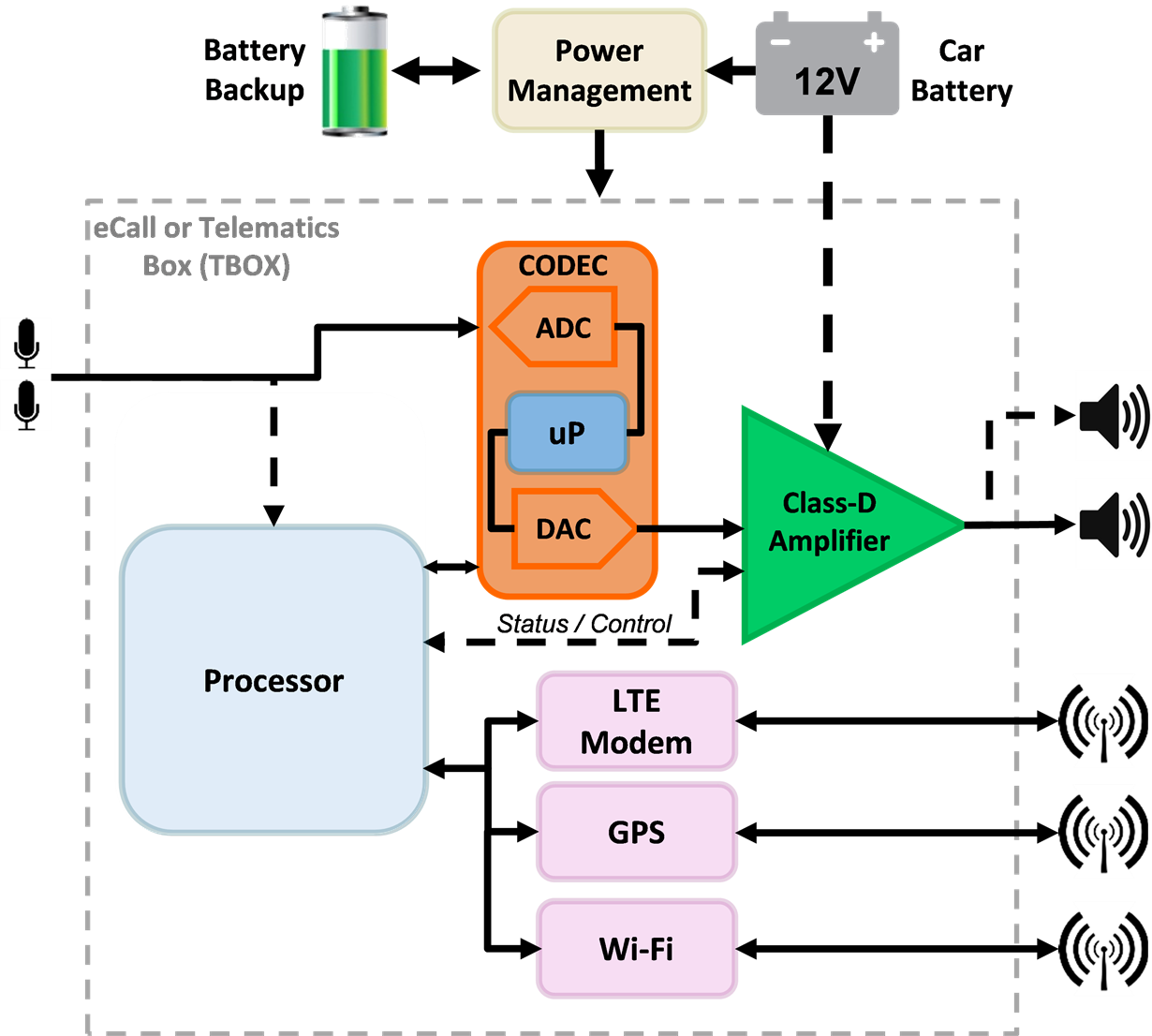SSZTBE4 April 2016 TAS5411-Q1 , TAS5421-Q1 , TAS5720L

Many government regulators have considered requiring emergency call (eCall) systems in automobiles. An eCall system will automatically contact emergency responders in the event of a serious road accident, send GPS coordinates to local emergency services, and wirelessly send airbag-deployment and impact-sensor information.
According to the European Commission, eCall will greatly diminish emergency-service response times as much as 50%; this faster response time will reduce the severity of injuries and save lives. When designing an eCall system, there are several things you need to take into consideration. In this blog post, I explore the audio function in eCall systems and at the end, I provide some advice for selecting amplifiers based on my experience.
Audio Is Driving eCall
Figure 1 is a very simplified block diagram of a typical eCall unit, sometimes called a telematics box.
 Figure 1 Typical eCall Unit Simplified
Block Diagram
Figure 1 Typical eCall Unit Simplified
Block DiagramIn Figure 1, you’ll notice that:
- The audio signal’s input front end and output are often combined into a single codec, which comprises one analog-to-digital converter (ADC) and one digital-to-analog converter (DAC). In very few cases, it’s comprised of two ADCs or two
DACs.
- As the audio signal path will verbally connect the driver to emergency services via phone, most systems only need one channel overall (one microphone, one ADC, one DAC, one Class-D amplifier and one speaker).
- The codec itself may include an embedded miniDSP for audio processing in the digital domain; a codec with miniDSP unburdens the processor from performing computations.
- There are certain cases where a codec may not be required, such as when a digital microphone connects directly to the microprocessor. Although more expensive to implement with maximum noise immunity, the audio signal path can remain digital all the way to the amplifier with the use of a digital-input Class-D amplifier.
- The audio line-level input from an external source is converted into digital samples by the ADC (inside the codec) and feed to the system’s processor.
- On the output side, DACs (in the codec) convert the digital audio signal from the processor to analog.
- As the signal coming from the DAC has both low-voltage and low-current capabilities, an audio amplifier provides the signal with the required higher voltage and current capabilities to drive the drivers in the speaker system.
- The eCall system operates from a backup battery system so that it can function even if an accident severs the connection to the car battery.
- The amplifier communicates results of its continuous diagnostics to the processor.
Audio Amplifiers: Class-AB vs. Class-D
Automotive system designers have two alternatives when selecting the best audio amplifier for their automotive head-unit systems: Class-AB or Class-D.
Class-AB audio amplifiers are today’s standard in automotive audio. They are linear amplifiers that generate no electromagnetic interference (EMI) and do not require many external electronic components. They are highly inefficient, however, and require substantial passive or even active thermal management in the form of heat sinks and fans.
On the other hand, Class-D audio amplifiers are highly efficient switching amplifiers that need very little thermal management; however, they do require output inductors that are not exempt from EMI concerns.
Battery-backup and Efficiency Considerations: System Design Trade-offs in eCall Systems
The eCall system’s backup battery poses an interesting design challenge: how to keep costs down while adopting a needed (and potentially expensive) battery backup, which may comprise one or many individual cells with different battery chemistries.
As I stated above, Class-AB audio amplifiers do not generate EMI and do not require many external electronic components; as such, you would think they would be ideal for an eCall system.
But their very low efficiency means that, in an eCall system, the charge from the battery backup would be mostly wasted as heat. This low efficiency comes at a very high cost, as many eCall systems demand between 10-20 minutes of “talk time” between emergency services and the driver. A system that uses a Class-AB amplifier will require additional battery cells to fulfill this requirement.
Class-D amplifiers’ high efficiency makes them ideal for eCall systems; their high efficiency means that a very low-cell-count cell battery (even from a single battery cell if selecting the right chemistry) can power an eCall system. This reduces total system cost dramatically, as well as weight and size.
Audio-amplifier Selection: Weighing the Pros and Cons
One question all eCall designers need to ask is if their system will still be functional after an accident.
A Class-D audio amplifier with integrated diagnostics communicates the results of these diagnostics to the processor.
In the case of an accident, the diagnostics help confirm that the speaker is still connected for verbal communication between the driver and emergency services. Or if the connection to the speaker is severed during an accident, it helps inform emergency services that the health status of the driver can’t be verified verbally.
TI’s automotive Class-D amplifiers’ high efficiency reduces heat dissipation and total system cost by greatly reducing the use of expensive high-cell-count batteries compared to Class-AB amplifiers.
Class-D amplifiers like the TAS5411-Q1 enable lower total system cost due to their high reliability and higher safety standards, as they integrate load diagnostics with I2C capabilities. The TAS5411-Q1 delivers 8W output power; in the event of an accident this helps to ensure that the emergency services operator will have communication with the driver.
If higher power is required, perhaps because the speaker is facing the dashboard and not the driver, then the TAS5421-Q1 is a good selection because it enables the same capabilities as the TAS5411-Q1, but delivers 22W of output power.
The TAS5720L is a good option for cost-sensitive applications.
Finally, to help automotive systems engineers simplify their audio signal-chain solution for eCall systems, TI’s TLV320AIC3209-Q1 enables a tailor-made single-channel audio signal.
Have you designed an eCall system? If so, what specifications were most important to you? Log in and leave a comment below.
Additional Resources
- Read about the differences between Class-AB and Class-D amplifiers in a recent Analog Wire blog post, “How Class-D amplifiers are closing the gap on hi-res Class-AB amplifiers.”
- View TI’s audio selection tool to see what device is best for your design.
- See ti.com/audio for audio subsystem diagrams, device recommendations and suggested design considerations.